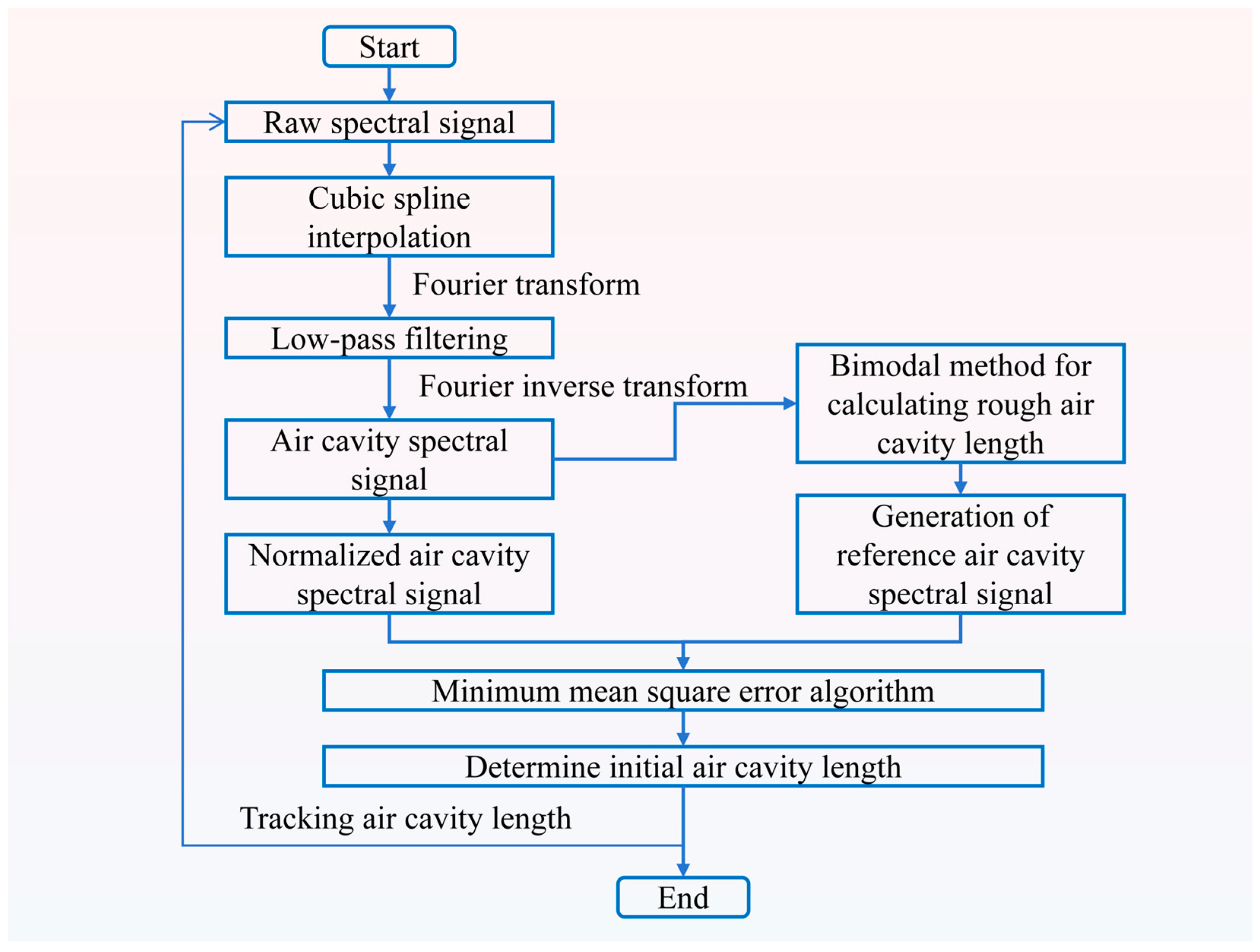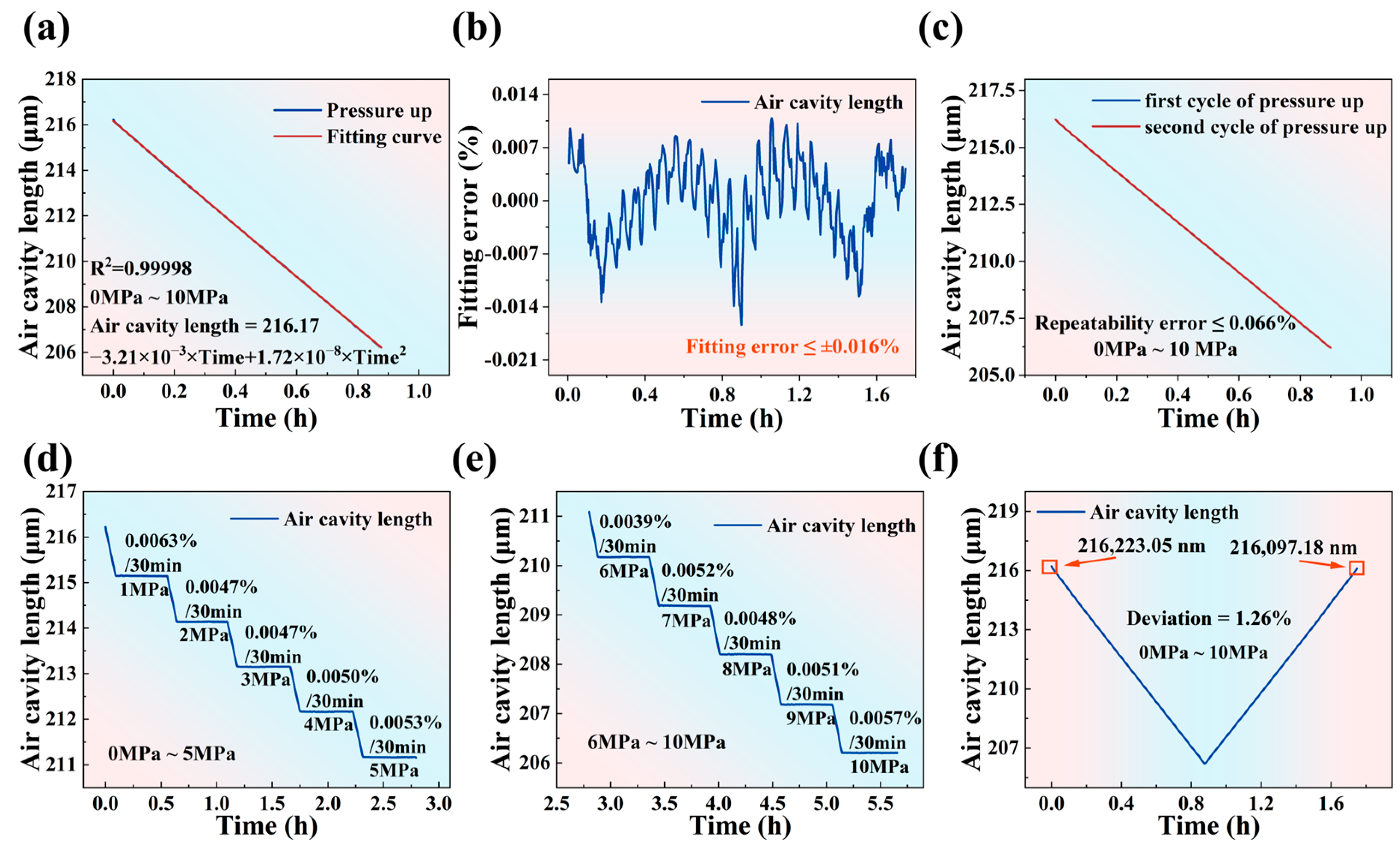Numerical and Experiment Analysis of Sapphire Sandwich-Structure Fabry–Perot Pressure Sensor through Fast Fourier Transform and Mean Square Error Demodulation Algorithm
Abstract
:1. Introduction
2. Test Systems and Sensor Structures
2.1. Test System
2.2. Sensor Structure
3. Simulation and Analysis
4. Experiments
5. Conclusions
Supplementary Materials
Author Contributions
Funding
Institutional Review Board Statement
Informed Consent Statement
Data Availability Statement
Conflicts of Interest
References
- Sharifzadeh, S.; Hendrick, P. Structural design and optimisation of a hypersonic aircraft based on aero-elastic deformations. In Proceedings of the 9th National Congress on Theoretical and Applied Mechanics, Brussels, Belgium, 9 May 2012. [Google Scholar]
- Tanguy, G.; MacManus, D.G. Characteristics of unsteady total pressure distortion for a complex aero-engine intake duct. Aerosp. Sci. Technol. 2018, 78, 297–311. [Google Scholar] [CrossRef]
- Qin, H.; Wang, W. Transient aerodynamic performances and pressure oscillations of a core engine combustor during start up. Aerosp. Sci. Technol. 2021, 115, 106838. [Google Scholar] [CrossRef]
- Albanakis, C.; Yakinthos, K. The effect of heat transfer on the pressure drop through a heat exchanger for aero engine applications. Appl. Therm. Eng. 2009, 29, 634–644. [Google Scholar] [CrossRef]
- Duan, B.; Hai, Z. A large-range and high-sensitivity fiber-optic fabry-perot pressure sensor based on a membrane-hole-base structure. Micromachines 2024, 15, 174. [Google Scholar] [CrossRef] [PubMed]
- He, J.; Xu, X. Stabilized ultra-high-temperature sensors based on inert gas-sealed sapphire fiber bragg gratings. ACS Appl. Mater. Interfaces 2022, 14, 12359–12366. [Google Scholar] [CrossRef] [PubMed]
- Shao, Z.; Wu, Y. All-sapphire fiber-optic pressure sensors for extreme harsh environments. Opt. Express 2022, 30, 3665–3674. [Google Scholar] [CrossRef] [PubMed]
- Habisreuther, T.; Elsmann, T.; Pan, Z. Long-term stable sapphire fiber bragg grating sensors at 1400 °C. In Proceedings of the 23rd International Conference on Optical Fiber Sensors, Santander, Spain, 2 June 2024. [Google Scholar]
- Li, W.; Liang, T. Fiber-optic fabry-perot pressure sensor based on sapphire direct bonding for high-temperature applications. Appl. Opt. 2019, 58, 1662–1666. [Google Scholar] [CrossRef] [PubMed]
- Wang, Z.; Chen, J. Sapphire fabry-perot interferometer for high-temperature pressure sensing. Appl. Opt. 2020, 59, 5189–5196. [Google Scholar] [CrossRef]
- Feng, X.; Jiang, Y. Diaphragm-free gas pressure sensor based on all-sapphire fiber Fabry-Perot interferometers. Appl. Opt. 2022, 61, 6584–6589. [Google Scholar] [CrossRef]
- Yi, J.; Lally, E. Demonstration of an all-sapphire fabry-perot cavity for pressure sensing. IEEE Photonics Technol. Lett. 2011, 23, 9–11. [Google Scholar] [CrossRef]
- Shao, Z.; Wu, Y. All-sapphire-based fiber-optic pressure sensor for high-temperature applications based on wet etching. Opt. Express 2021, 29, 4139–4146. [Google Scholar] [CrossRef] [PubMed]
- Yi, J. Sapphire fabry-perot pressure sensor at high temperature. IEEE Sens. J. 2021, 21, 1596–1602. [Google Scholar] [CrossRef]
- Jiang, Y. High-resolution interrogation technique for fiber optic extrinsic Fabry-Perot interferometric sensors by the peak-to-peak method. Appl. Opt. 2008, 47, 925–932. [Google Scholar] [CrossRef] [PubMed]
- Chen, H.; Zhang, Y. Squared peak-to-peak algorithm for the spectral interrogation of short-cavity fiber-optic fabry-perot sensors. Appl. Opt. 2020, 59, 1198–1205. [Google Scholar] [CrossRef] [PubMed]
- Shin, D.; Matsukuma, H. Improved peak-to-peak method for cavity length measurement of a fabry-perot etalon using a mode-locked femtosecond laser. Opt. Express 2023, 31, 25797–25814. [Google Scholar] [CrossRef]
- Yang, Y.; Tian, D. A fiber-optic displacement sensor using the spectral demodulation method. J. Light. Technol. 2018, 36, 3666–3671. [Google Scholar] [CrossRef]
- Fu, X.; Lu, P. Phase demodulation of interferometric fiber sensor based on fast fourier analysis. Opt. Express 2017, 25, 21094–21106. [Google Scholar] [CrossRef]
- Zhang, P.; Wang, Y. A high-speed demodulation technology of fiber optic extrinsic fabry-perot interferometric sensor based on coarse spectrum. Sensors 2021, 21, 6609. [Google Scholar] [CrossRef]
- Qi, B.; Winder, D. Quadrature phase-shifted optical demodulator for low-coherence fiber-optic fabry-perot interferometric sensors. Opt. Express 2019, 27, 7319–7329. [Google Scholar] [CrossRef]
- Zhang, W.; Lu, P. Four-wavelength quadrature phase demodulation technique for extrinsic fabry-perot interferometric sensors. Opt. Lett. 2022, 47, 2406–2409. [Google Scholar] [CrossRef]
- Zhao, Y.; Liu, Q. Passive quadrature phase demodulation of a dual-cavity fabry-perot ultrasound sensor. IEEE Photonics Technol. Lett. 2022, 34, 733–736. [Google Scholar] [CrossRef]
- Guo, M.; Chen, K. High-sensitivity fiber-optic low-frequency acoustic detector based on cross-correlation demodulation. J. Light. Technol. 2022, 40, 4481–4488. [Google Scholar] [CrossRef]
- Zhang, G.; Xiong, Z. Low-frequency optical fiber fabry-perot acoustic sensor based on all-phase cross-correlation demodulation. J. Light. Technol. 2022, 40, 7431–7438. [Google Scholar] [CrossRef]
- Cheung, Y.; Jing, Z. Parallel cross-correlation algorithm for the fast interrogation of high-finesse fiber-optic fabry-perot sensors. J. Light. Technol. 2023, 41, 4522–4530. [Google Scholar] [CrossRef]
- Shao, Z.; Wu, Y. Excellent repeatability, all-sapphire Fabry Perot optical Pressure sensor based on wet etching and direct bonding for Harsh Environment Applications. Opt. Express 2021, 29, 19831–19838. [Google Scholar] [CrossRef] [PubMed]
- Guo, Z.; Lv, W. Absolute single cavity length interrogation of fiber-optic compound Fabry-Perot pressure sensors through a white light non-scanning correlation method. Sensors 2019, 19, 1628. [Google Scholar] [CrossRef] [PubMed]
- Cui, Y.; Jiang, Y. A dual-cavity Fabry-Perot interferometric fiber-optic sensor for the simultaneous measurement of high-temperature and high-gas-pressure. IEEE Access 2020, 8, 80582–80587. [Google Scholar] [CrossRef]
- Zhang, W.; Yu, J. High-precision cavity length demodulation method for fiber-optic Fabry-Perot Sensors Based on Dual Superluminescent Diodes. Sensors 2022, 22, 5898. [Google Scholar] [CrossRef] [PubMed]
- Wang, B.; Niu, Y. A high temperature sensor based on sapphire fiber Fabry-Perot interferometer. IEEE Photonics Technol. Lett. 2020, 32, 89–92. [Google Scholar] [CrossRef]
- Ma, W.; Shao, Z. Sensitivity-enhanced fiber-optic sensor based on a drilled PDMS diaphragm for ultrasound imaging of seismic physical model. IEEE Trans. Instrum. Meas. 2022, 71, 1–6. [Google Scholar] [CrossRef]
- Ren, Q.; Jia, P. Dual-wavelength demodulation technique for interrogating a shortest cavity in multi-cavity fiber-optic Fabry–Pérot sensors. Opt. Express 2021, 29, 32658–32669. [Google Scholar] [CrossRef]
- Zhao, A.; Ren, Q. Extensible multi-wavelength interrogation method for arbitrary cavities in low-fineness multi-cavity Fabry-Pérot interferometric sensors. Opt. Express 2024, 32, 6141–6153. [Google Scholar] [CrossRef]
- Wei, X.; Yan, H. A visible-light spectral demodulation system for fiber-optic SiC Fabry-Perot sensors. Optik 2022, 251, 168441. [Google Scholar] [CrossRef]
- Liu, W.; Yang, T. Combined Interrogation Algorithm of Phase Function and Minimum Mean Square Error for Fiber-Optic Fabry-Perot Micro-Pressure Sensors Based on White Light Interference. J. Light. Technol. 2023, 41, 3241–3248. [Google Scholar] [CrossRef]
- Yu, L.; Lang, J. A Hybrid Demodulation Method of Fiber-optic Fabry-Perot Pressure Sensor. In Proceedings of the 2013 International Conference on Optical Instruments and Technology: Optical Sensors and Applications, Beijing, China, 17–19 November 2013. [Google Scholar]
- Gui, X.; Galle, M. Demodulation method combining virtual reference interferometry and minimum mean square error for fiber-optic Fabry–Perot sensors. Chin. Opt. Lett. 2018, 16, 010606. [Google Scholar]
- Dai, X.; Wang, M. The application of the FFT algorithm associated with CZT in the demodulation of Fabry-Perot pressure sensors. Adv. Sens. Syst. Appl. III 2008, 6830, 225–236. [Google Scholar]






| Main Method | Air Cavity Length (um) | Error (nm) | Error (%) | Refs. |
|---|---|---|---|---|
| PTP | 2515–2610 | <2000 | 2.11 | [15] |
| DW | / | <35 | / | [33] |
| EMW | / | <20 | / | [34] |
| PCC | / | <0.3 | / | [26] |
| WLNSC | 60–95 | <14 | 0.04 | [28] |
| SCC | 15–25 | <0.43 | 0.0437 | [35] |
| MMSE | 16.03–16.14 | <1.2 | 0.88 | [36] |
| MMSE + nDFT | 241–243 | <0.5 | 0.4 | [37] |
| MMSE + VR | / | <4.8 | / | [38] |
| FFT | / | / | 0.3 | [18] |
| FFT + MLE | 300.5–303.5 | 15 | 0.005 | [19] |
| FFT + CZT | 397–403 | <0.6 | 0.01 | [39] |
| FFT + MSE | 206–216 | <0.1 | 0.0008 | This work |
| Parameters | Value |
|---|---|
| L1 | 600 μm |
| L2 | 206~216 μm |
| W | 1520~1570 nm |
| I0 | 1 a.u. |
| R1, R2, R3 | 0.075 |
| n1 | 1.765 |
| n2 | 1.000 |
| c | 3 × 108 m/s |
Disclaimer/Publisher’s Note: The statements, opinions and data contained in all publications are solely those of the individual author(s) and contributor(s) and not of MDPI and/or the editor(s). MDPI and/or the editor(s) disclaim responsibility for any injury to people or property resulting from any ideas, methods, instructions or products referred to in the content. |
© 2024 by the authors. Licensee MDPI, Basel, Switzerland. This article is an open access article distributed under the terms and conditions of the Creative Commons Attribution (CC BY) license (https://creativecommons.org/licenses/by/4.0/).
Share and Cite
Hai, Z.; Su, Z.; Liang, R.; Guo, M.; Zhu, H.; Chen, J.; Zhang, Q.; Chen, Y.; Lin, R.; Zhang, Y.; et al. Numerical and Experiment Analysis of Sapphire Sandwich-Structure Fabry–Perot Pressure Sensor through Fast Fourier Transform and Mean Square Error Demodulation Algorithm. Materials 2024, 17, 3649. https://doi.org/10.3390/ma17153649
Hai Z, Su Z, Liang R, Guo M, Zhu H, Chen J, Zhang Q, Chen Y, Lin R, Zhang Y, et al. Numerical and Experiment Analysis of Sapphire Sandwich-Structure Fabry–Perot Pressure Sensor through Fast Fourier Transform and Mean Square Error Demodulation Algorithm. Materials. 2024; 17(15):3649. https://doi.org/10.3390/ma17153649
Chicago/Turabian StyleHai, Zhenyin, Zhixuan Su, Rui Liang, Maocheng Guo, Hongtian Zhu, Jun Chen, Qi Zhang, Yue Chen, Runze Lin, Yihang Zhang, and et al. 2024. "Numerical and Experiment Analysis of Sapphire Sandwich-Structure Fabry–Perot Pressure Sensor through Fast Fourier Transform and Mean Square Error Demodulation Algorithm" Materials 17, no. 15: 3649. https://doi.org/10.3390/ma17153649






